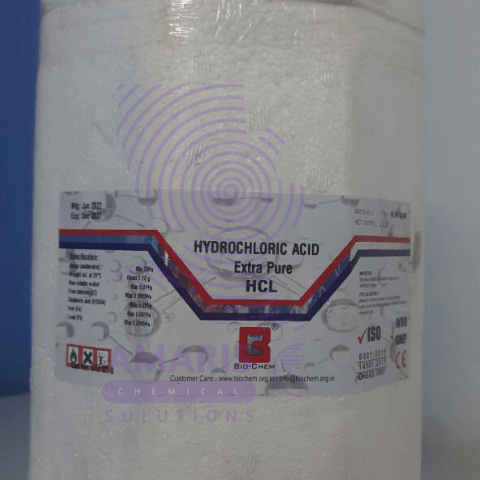The Science Behind Hydrochloric Acid: Applications and Safety Measures

Hydrochloric acid (HCl) is one of the most widely used acids in various industries, known for its strong corrosive properties and extensive applications. As a highly reactive and powerful acid, it plays a vital role in manufacturing, laboratory research, and even biological processes. Understanding its applications and safety measures is crucial for its effective and responsible use.
Chemical Properties of Hydrochloric Acid
Hydrochloric acid is a colorless, highly pungent solution of hydrogen chloride gas in water. It is a strong monoprotic acid, meaning it completely dissociates in water to release hydrogen ions (H+), making it highly acidic. With a pH of around 1 to 2 in concentrated form, HCl has a strong ability to dissolve metals, react with bases to form salts, and serve as a catalyst in chemical reactions.
Industrial and Laboratory Applications
- Chemical Manufacturing: HCl is used in the production of PVC (polyvinyl chloride), fertilizers, dyes, and pharmaceuticals. It serves as a key ingredient in many industrial chemical processes.
- Metal Processing: The acid is commonly used for pickling steel, a process that removes rust and scale from metal surfaces to prepare them for further treatment.
- Food Industry: In regulated amounts, hydrochloric acid is used as a food additive and pH regulator in various products, including sauces and gelatin.
- Laboratory Use: HCl is essential for titrations, preparation of acid solutions, and various research applications in chemistry labs.
- Biological Role: The human stomach naturally produces hydrochloric acid to aid digestion by breaking down food and killing harmful bacteria.
Safety Measures for Handling Hydrochloric Acid
Due to its corrosive nature, proper precautions must be taken when handling hydrochloric acid:
- Personal Protective Equipment (PPE): Always wear gloves, safety goggles, and lab coats to prevent skin and eye contact.
- Ventilation: Work in a well-ventilated area or fume hood to avoid inhaling harmful fumes.
- Storage: Keep HCl in tightly sealed containers made of corrosion-resistant materials such as glass or plastic.
- Neutralization and Disposal: Spills should be neutralized using baking soda or an appropriate base before disposal. Always follow local regulations for chemical waste management.
Conclusion
Hydrochloric acid is a powerful and versatile chemical with applications across multiple industries. While its benefits are immense, handling it with care and following strict safety protocols is essential. Understanding its chemical properties and potential hazards ensures that HCl is used efficiently and responsibly, making it an indispensable component in scientific and industrial fields.


 Emollients
Emollients Humectants
Humectants UV Filters
UV Filters Surfactants (cosmetic)
Surfactants (cosmetic) Preservatives (cosmetic)
Preservatives (cosmetic) Fragrances and Essential Oils
Fragrances and Essential Oils Antioxidants (cosmetics)
Antioxidants (cosmetics)
 Solvents (lab)
Solvents (lab) Chromatography Chemicals
Chromatography Chemicals Microbiology and Cell Culture Reagents
Microbiology and Cell Culture Reagents Biochemical Reagents
Biochemical Reagents Inorganic and Organic Standards
Inorganic and Organic Standards LABORATORY EQUIPMENT & APPARATUS
LABORATORY EQUIPMENT & APPARATUS Spectroscopy Reagents
Spectroscopy Reagents Molecular Biology Reagents
Molecular Biology Reagents
 Precious Metal Extraction Agents
Precious Metal Extraction Agents
 Plasticizers
Plasticizers Polymerization Initiators
Polymerization Initiators Stabilizers
Stabilizers Monomers
Monomers Fillers and Reinforcements
Fillers and Reinforcements Antioxidants (plastics)
Antioxidants (plastics) Colorants (plastic pigments,Dyes)
Colorants (plastic pigments,Dyes)
 Fertilizers
Fertilizers Plant Growth Regulators
Plant Growth Regulators Soil Conditioners
Soil Conditioners Animal Feed Additives
Animal Feed Additives Biostimulants
Biostimulants
 Dough Conditioners
Dough Conditioners Flour Treatments
Flour Treatments Fat Replacers
Fat Replacers Preservatives (baking)
Preservatives (baking)
 Surfactants (cleaning)
Surfactants (cleaning) Builders
Builders Bleaching Agents
Bleaching Agents Enzymes
Enzymes Solvents (cleaning)
Solvents (cleaning) Fragrances
Fragrances Disinfectant
Disinfectant Metal cleaning
Metal cleaning
 Binders/Resins
Binders/Resins Pigments
Pigments Solvents (paint)
Solvents (paint) Additives
Additives Driers
Driers Anti-Corrosion Agents
Anti-Corrosion Agents Specialty Coatings
Specialty Coatings Functional Coatings
Functional Coatings Application-Specific Coatings
Application-Specific Coatings
 Sealants and Adhesives
Sealants and Adhesives
 Biodegradable Surfactants
Biodegradable Surfactants Bio-based Solvents
Bio-based Solvents Renewable Polymers
Renewable Polymers Carbon Capture Chemicals
Carbon Capture Chemicals Wastewater Treatment Chemicals
Wastewater Treatment Chemicals
 Preservatives (food)
Preservatives (food) Flavor Enhancers
Flavor Enhancers Acidulants
Acidulants Sweeteners
Sweeteners Emulsifiers
Emulsifiers Antioxidants (food)
Antioxidants (food) Colorants (food)
Colorants (food) Nutrient Supplements
Nutrient Supplements Nutraceutical Ingredients
Nutraceutical Ingredients
 Fresh Herbs
Fresh Herbs Whole Spices
Whole Spices Ground Spices
Ground Spices Spice Blends
Spice Blends
 Surfactants(oil)
Surfactants(oil)
 Antibiotics
Antibiotics Active Pharmaceutical Ingredients
Active Pharmaceutical Ingredients Excipients
Excipients Vaccine Adjuvants
Vaccine Adjuvants Nutraceutical Ingredients
Nutraceutical Ingredients Solvents (pharmaceutical)
Solvents (pharmaceutical)
 Automotive chemicals
Automotive chemicals Pyrotechnic Chemicals
Pyrotechnic Chemicals


 Vulcanizing Agents
Vulcanizing Agents Accelerators & Retarders
Accelerators & Retarders Antidegradants
Antidegradants Reinforcing Agents
Reinforcing Agents Plasticizers & Softeners
Plasticizers & Softeners Fillers & Extenders
Fillers & Extenders Blowing Agents
Blowing Agents Adhesion Promoters
Adhesion Promoters











